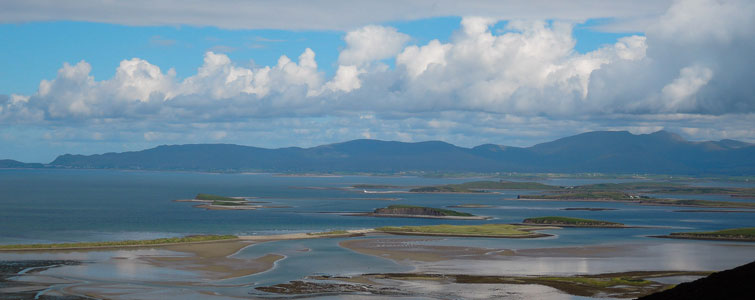Clew Bay Islands in Co. Mayo

Clew Bay, the most spectacular bay in Ireland overlooked by Croagh Patrick, is scattered with 365 islands, one for every day of the year. The number includes also bits of saltings; 117 of them are Ireland's best example of drumlins of limestone, scoured by ice sheet. They come up in all shapes: ovals, lozenges, snakes, dragons, arrowheads or long-legged beasties.
Clare Island, the biggest island, guards the entrance of the bay; only six islands are inhabited all year round.
According to legend, the ancient name for West Mayo ‘Umhall’ is related to these islands. This name could come from the translation of the Irish word for apples, ubhall or ull. It is thought the islands, which look like apples floating in the water, could have given rise to this connection.
In the 16th century these islands were extremely important for Grace O’Malley, the Pirate Queen, and her sea kingdom. They were perfect traps into which to drive passing vessels or perfect places to hide and to intercept enemy ships.
Their Irish names could be curious: Roeillaun (red earthen cliff), Inisherky, Inishcooa, Inishitra, Inishdooney, Inishkee, Muckinish, Inishoo, Inishgowla (island of the fork), Carraigeen-na-Francach (the rock of the Frenchman), Collanmore Island, Inishlyre, Inishgort, Inisheany (the meeting place), Clynish. Some of them had stories to tell.
Inisheany (the meeting place), on the sea route to Westport, was a gathering point for trade between ships and graziers from the Clew Bay area. According the Annals of the Four Masters, in 1239 a galley fleet, captained by O’Dowdy of Connaught, gathered here. The fleet, made up of 56 ships, was the greatest ever seen in the West. Some years later, a violent episode happened on this island. The Normans landed there using boats supplied by the O’Flaherty and killed many men of the O’Connor’s clan come ashore.
Inishgowla (the island of the fork) offered a sheltered anchorage to fishermen in the bay and, it is said, it boasted a Gentry Tree on the top of the hill where the fairies danced at moonlight.
Carraigeen-na-Francach (the rock of the Frenchman), home to a large number of seals, takes its name from a tragedy. A Breton fishing vessel broke up on the rocks and all fishermen were drowned.
On Inishoo, it is said a cow of exceptional beauty was born. It was called the White Cow. When the owners decided to sell it they came to the little island and tried to catch it but there were no traces of the heifer and no hoof marks, it simply disappeared. So the family sold the island thinking the wee people had made a spell on it.
